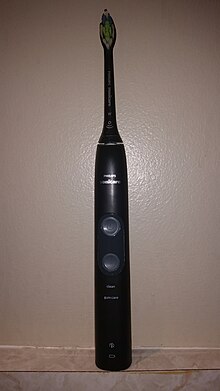This article has multiple issues. Please help
improve it or discuss these issues on the
talk page. (
Learn how and when to remove these template messages)
|
Sonicare is the brand name of an electric toothbrush produced by Philips.
Product and technology

The brush head vibrates at hundreds of times per second, with the latest models at 31,000 strokes per minute (517 Hz) or 62,000 movements per minute [1] (1033 Hz). Rather than connecting to its charger with conductors, it uses inductive charging—the charger includes the primary winding of the voltage-reducing transformer and the handle of the brush includes the secondary winding. The replaceable head is also driven magnetically. Currently, there are multiple types of Sonicare brushes.
Clinical research
Individual clinical research has shown Sonicare toothbrushes to be more effective than comparable Oral-B electric toothbrushes in reduction of gingival inflammation and therefore improvement in periodontal health. [2] However a 2004 review of 29 studies concluded that only electric toothbrushes with rotational/oscillation movement removed more plaque than other brushes when correctly used. [3] A second review found no clinical evidence for the dynamic fluid activity of the Sonicare toothbrush being more effective in plaque removal than an Oral-B oscillating/rotating electric toothbrush. [4] A 2007 study comparing the two found the rotation/oscillation brush to be more effective in single-use plaque reduction. [5]
An additional study showed that while both Sonicare and Oral B electric toothbrushes do better than manual toothbrushes in removing plaque, reducing gingival inflammation, and reducing probing depths, the Sonicare showed significantly more improvement than Oral B. The percentage reduction in inflammation from baseline at 6 months was 31.9% for Sonicare and 18.1% for Oral B. In regards to probing depth, Sonicare showed a mean reduction of 0.84 mm from baseline at 6 months, while Oral B showed an average reduction of 0.39 mm. [6]
Individual studies have shown that Sonicare toothbrushes are more effective at removing plaque and reducing gingivitis than manual toothbrushes. [7] [8]
History
In 1987, David Giuliani, an entrepreneur with a background in electrical engineering, met with University of Washington professors Drs. David Engel and Roy Martin. They formed a new company named GEMTech to promote a dental hygiene device using a piezoelectric multimorph transducer. After several years of research and creating prototypes, the Sonicare toothbrush was introduced in 1992 [9]
In 1995, GEMTech changed its name to Optiva Corporation. [9] In October 2000, Philips Domestic Appliances and Personal Care, a division of Philips, acquired the company. A few months later Optiva Corporation changed its name to Philips Oral Healthcare, Inc. By the end of 2001, Sonicare had become the number-one selling rechargeable power toothbrush in the United States. [10] In 2003, to improve Philips brand recognition in the US, Philips rebranded the Sonicare toothbrush as "Philips Sonicare".
See also
References
- ^ "Press Information - Philips IFA 2016" (PDF).[ dead link]
- ^ Robinson, PJ; Maddalozzo, D; Breslin, S (1997). "A six-month clinical comparison of the efficacy of the Sonicare and the Braun Oral-B electric toothbrushes on improving periodontal health in adult periodontitis patients". J Clin Dent. 8 (1 Spec No): 4–9. PMID 9487838.
- ^ Penick, Catherine (2004). "Power toothbrushes: a critical review". International Journal of Dental Hygiene. 2 (1): 40–4. doi: 10.1111/j.1601-5037.2004.00048.x. PMID 16451451.
- ^ Warren, PR; Cugini, MA; Chater, BV; Strate, J (December 2004). "A review of the clinical efficacy of the Oral-B oscillating/rotating power toothbrush and the Philips Sonicare toothbrush in normal subject populations". International Dental Journal. 54 (6): 429–37. doi: 10.1111/j.1875-595X.2004.tb00300.x. PMID 15633499.
- ^ Biesbrock, AR; Bartizek, RD; Walters, PA; Warren, PR; Cugini, M; Goyal, CR; Qaqish, J (2007). "Clinical evaluations of plaque removal efficacy: an advanced rotating-oscillating power toothbrush versus a sonic toothbrush". J Clin Dent. 18 (4): 106–11. PMID 18277740.
- ^ Robinson, PJ; Maddalozzo, D; Breslin, S (1997). "A six-month clinical comparison of the efficacy of the Sonicare and the Braun Oral-B electric toothbrushes on improving periodontal health in adult periodontitis patients". J Clin Dent. 8 (1 Spec No): 4–9. PMID 9487838.
- ^ Pelka, Anna-Kristina; Nagler, Tonia; Hopp, Imke; Petschelt, Anselm; Pelka, Matthias Anton (August 2011). "Professional brushing study comparing the effectiveness of sonic brush heads with manual toothbrushes: a single blinded, randomized clinical trial". Clin Oral Investig. 15 (4): 451–60. doi: 10.1007/s00784-010-0411-0. PMID 20387085. S2CID 23349358.
- ^ Moritis, K; Jenkins, W; Hefti, A; Schmitt, P; McGrady, M (2008). "A randomized, parallel design study to evaluate the effects of a Sonicare and a manual toothbrush on plaque and gingivitis". J Clin Dent. 19 (2): 64–8. PMID 18763689.
- ^ a b Bissett, Gaby (November 24, 2022). "Sonicaring for 30 years". Dentistry Online.
- ^ "Sonicare - Our Story". Sonicare.com. Retrieved 2008-06-04.